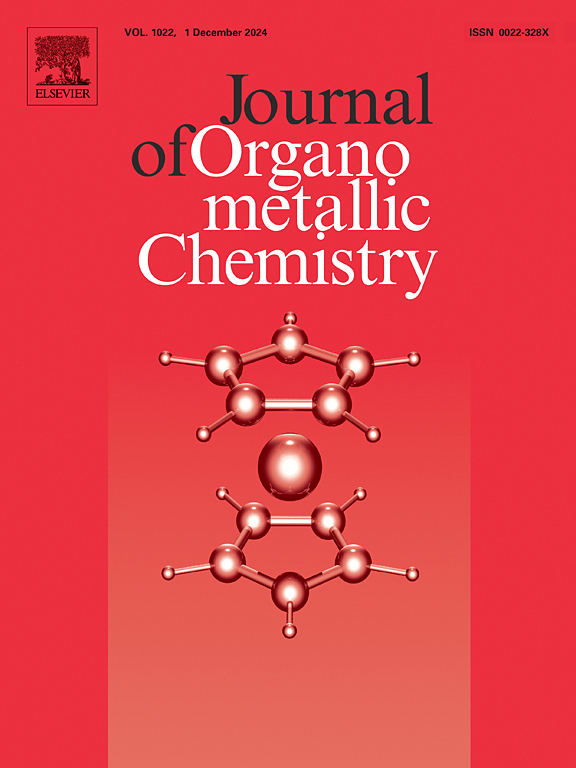Design and synthesis of decorated palladium nanoparticles on chitosan-tannic acid modified magnetic nanoparticles and evaluation of its catalytic application in the Heck coupling reactions
IF 2.1
3区 化学
Q3 CHEMISTRY, INORGANIC & NUCLEAR
引用次数: 0
Abstract
In the present research, we introduce the creation and evaluation of a novel magnetic composite that incorporates palladium nanoparticles supported over modified Fe3O4 nanoparticles using chitosan-tannic acid (CS-TA) mixed polymers. The developed nanocatalyst (Fe3O4@CS-TA/PdNPs) was assessed using different characterized methods involving FESEM, EDS, XRD, TEM, VSM ICP-OES spectroscopy. This innovative catalyst demonstrates an economical and efficient approach for C![]() C bond formation, exhibiting remarkable reactivity, efficiency, and exceptional durability in Heck coupling with different haloarenes and olefins. As a heterogeneous palladium catalyst, Fe3O4@CS-TA/PdNPs can be easily retrieved and reused over several cycles without a notable decline in its catalytic efficacy. Additional benefits of this approach involving economic feasibility, easy extraction processes, and less palladium loss.
C bond formation, exhibiting remarkable reactivity, efficiency, and exceptional durability in Heck coupling with different haloarenes and olefins. As a heterogeneous palladium catalyst, Fe3O4@CS-TA/PdNPs can be easily retrieved and reused over several cycles without a notable decline in its catalytic efficacy. Additional benefits of this approach involving economic feasibility, easy extraction processes, and less palladium loss.

壳聚糖-单宁酸修饰磁性纳米粒子修饰钯纳米粒子的设计与合成及其在Heck偶联反应中的催化应用评价
在本研究中,我们介绍了一种新型磁性复合材料的创建和评估,该复合材料采用壳聚糖-单宁酸(CS-TA)混合聚合物,将钯纳米粒子负载在改性Fe3O4纳米粒子上。采用FESEM、EDS、XRD、TEM、VSM ICP-OES等不同表征方法对制备的纳米催化剂(Fe3O4@CS-TA/PdNPs)进行了表征。这种创新的催化剂展示了一种经济高效的CC键形成方法,在与不同卤代烃和烯烃的Heck偶联中表现出卓越的反应性、效率和耐久性。作为一种多相钯催化剂,Fe3O4@CS-TA/PdNPs可以很容易地回收和重复使用,并且在几个循环中没有明显的催化效果下降。这种方法的其他优点包括经济可行性,提取过程简单,钯损失少。
本文章由计算机程序翻译,如有差异,请以英文原文为准。
求助全文
约1分钟内获得全文
求助全文
来源期刊

Journal of Organometallic Chemistry
化学-无机化学与核化学
CiteScore
4.40
自引率
8.70%
发文量
221
审稿时长
36 days
期刊介绍:
The Journal of Organometallic Chemistry targets original papers dealing with theoretical aspects, structural chemistry, synthesis, physical and chemical properties (including reaction mechanisms), and practical applications of organometallic compounds.
Organometallic compounds are defined as compounds that contain metal - carbon bonds. The term metal includes all alkali and alkaline earth metals, all transition metals and the lanthanides and actinides in the Periodic Table. Metalloids including the elements in Group 13 and the heavier members of the Groups 14 - 16 are also included. The term chemistry includes syntheses, characterizations and reaction chemistry of all such compounds. Research reports based on use of organometallic complexes in bioorganometallic chemistry, medicine, material sciences, homogeneous catalysis and energy conversion are also welcome.
The scope of the journal has been enlarged to encompass important research on organometallic complexes in bioorganometallic chemistry and material sciences, and of heavier main group elements in organometallic chemistry. The journal also publishes review articles, short communications and notes.
 求助内容:
求助内容: 应助结果提醒方式:
应助结果提醒方式:


